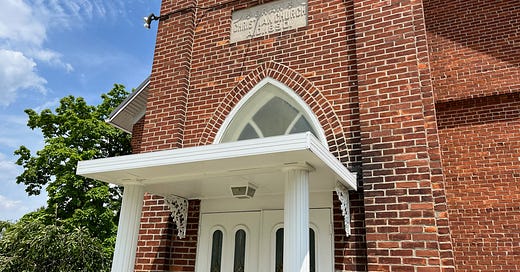It is better to go to a house of mourning than to go to a house of feasting, because that is the end of every person, and the living takes it to heart. (Ecclesiastes 7:2 NASB)
Yesterday, I found myself in an all too familiar setting; gathered alongside friends and family and strangers, memorializing a life and offering our official goodbyes to a dear loved one. Whether it’s just been an unlucky stretch of years or the natural result of getting older, it seems that it is now my lot to visit the house of mourning several times a year. Scripture tells me that it is good to be in this house, but it’s no one’s aim (and surely not mine) to become a regular at this sorrowful abode.
This time we gathered for Bill, a long-time friend of my wife’s family who almost made it to his 86th birthday. Bill was a treasure. The handful of interactions I had with him over the years were all pleasant. He was a man of pure faith, a lover of music and family, full of vitality and wit and overflowing with joy. This world will not be the same without him.
In my days, I’ve mourned in dozens of funeral homes and a handful of modern churches, but this was my first memorial service in a small country church and, I must confess, I was not disappointed.
Oran Christian Church sits just off the road among a small cluster of homes in the heart of Shelby County, Ohio; a place where fields of beans, wheat, and corn surround some of the kindest people you’ll ever meet. The small gravel parking lot was at capacity so we joined the others parking on any flat plot of grass we could find nearby. The old cemetery across the street was also at capacity, having received its last resident at the beginning of the 20th century.
According to the inscription above the entrance, the small brick chapel was built 134 years ago, when the honorable Benjamin Harrison was our 23rd president (one of eight presidents that came from Ohio). The chapel interior had obviously been updated since then, though likely not in the last decade or two. It was orderly and welcoming and not without some essential modern innovations: air conditioning, a good clear sound system, and, my favorite, padded pews.
At half past one the pastor and the choir took their places on the elevated platform in the front of the church. I hesitate to call it a stage as it bears no resemblance to the front of most houses of worship built in the last fifty years. The were no tv’s or projector screens, no drum sets or fog machines and there were no spot lights, unless you count the single bulb above the framed picture of Jesus on the wall just behind the choir. The classic portrait, a reproduction of the famous Head of Christ painting from 1940, was fitting for a space with this much history.
On the left side of the platform a simple lectern stands in front of a few high-back chairs. On the right, a choir loft for no more than a dozen voices sits nestled behind an electric piano.
The pastor, who by all appearances has personally witnessed several generations come and go in his time, stood and began the memorial liturgy, a simple, yet beautiful, dance between the comforting words of scripture and hope-filled lyrics sung by the choir. The choir itself was something to behold. Six of its ten members were made up of three generations of one family, a testimony to a strong faith and God’s generational grace.
The choir was joyous and mostly smiles, but occasionally, as they remembered that the words on their lips were sung for their newly-departed friend, grief would break through. When the young pianist delivered a stirring version of It Is Well With My Soul, emotion overtook the rest of us.
When I was young, I couldn’t imagine why a house of mourning would have any value, but as I sat in my pew looking around at a group of simple folks who, like me, are helpless to slow the march of time, it only makes sense. We are all destined to die once (Hebrews 9:27) and, contrary to what the lies and elixirs of this world promise, there’s nothing we can do to stop it. Yet, if we’re wise, we will ready ourselves for that inevitable day, turning to the Lord in repentance and receiving the blessed gift of eternal life that He offers (John 3:16, Romans 10:9-10). That day will come sooner than we expect and it’s best if we take action while it’s still called today.
That’s one of the many important things that a house of mourning can teach us. As we witness the generations ahead of us pass into glory, we know with solemn certainty that our time is not far off. I think that’s why you often see older folks filling the most pews. When your days are marked by aches and pains, wrinkles and age spots, thickening glasses and thinning hairlines, there’s no denying that these fleshly tents are but temporary.
Yesterday’s memorial service in the old Oran church was not flashy, spectacular, or bold. But, it was pure, sacred, and holy. Inside those aged plaster walls that have received the sermons and songs and grieving cries of over six generations, our good friend Bill was honored, our hurting souls were encouraged, and the hope of the Gospel of Jesus Christ was plainly delivered.
Yes, hope can be found in the house of mourning. Even when - and maybe especially when - that house is a small country church.
~~







Thank you.
A very inspiring look at passing